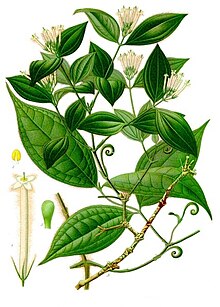Curare

This page is about the plant toxins. For the DC Comics character, see Curare.
Curare is a common name for various dart poisons originating from South America. The three main types, or families of curare are: the tubocurare (also known as tube or bamboo curare, because of its packing into hollow bamboo tubes; main toxin is D-tubocurarine), the calebas curare (also called "gourd curare" by older British classifications, being packed into hollow gourds; main toxins are alloferine and toxiferine) and the pot curare (packed in terracota pots; main toxins are protocurarine, protocurine, and protocuridine). Of these three families, some formulas belonging to the calebas curare are the most toxic, relative to their LD50 values.
The most known and historically (because of its medical applications) important toxin is however the D-tubocurarine. It was introduced into anesthesiology in early 1940s as a muscle relaxant for surgery. It is important to know, that curares are active (i.e. toxic or muscle relaxing, dependant on the intention of their use) only if given/applied parenterally, that is, by an injection, or direct wound contamination by poisoned dart/arrow tip. Upon ingestion (per os), curares are inactive. This is crucial, because the native tribes use curares mainly for hunting purposes, thus the poisoned prey must be innoxious upon eating. In medicine, curare has been superseded by a number of curare-like agents (pancuronium, an alkaloid-like substance with steroidal skeleton in its molecule), that have a similar pharmacodynamic profile but with fewer side effects.
Curare is an example of a non-depolarizing muscle relaxant which blocks the nicotinic receptors, one of the two types of cholinergic (acetylcholine) receptors on the post synaptic membrane of the neuromuscular junction.
Curare has also been used historically as a paralyzing poison by South American indigenous people. The prey is killed by asphyxiation as the respiratory muscles are unable to contract resulting in apnea.
Curare and anaesthesia
Muscle relaxants are used in modern anaesthesia for many reasons, such as providing optimal operating conditions and facilitating intubation of the trachea. Before muscle relaxants, anaesthesiologists needed to use larger doses of the anaesthetic agent, such as ether or cyclopropane to achieve these aims. Such deep anaesthesia risked killing patients that were elderly or had heart conditions.Template:Inote
The source of curare in the Amazon was first researched by Richard Evans Schultes in 1941. Since the 1930s, it was being used in hospitals as a muscle relaxant. He discovered that different types of curare called for as many as 15 ingredients, and in time helped to identify more than 70 species that produced the drug [1].
On January 23, 1942, Dr. Harold Griffith and Dr. Enid Johnson gave a synthetic preparation of curare (Intracostin) to a patient undergoing an appendectomy (to supplement conventional anaesthesia). Modern anaesthetists have at their disposal a variety of muscle relaxants for use as a standard component of anaesthesia.
The ability to produce muscle relaxation independently from anaesthesia has permitted anaesthesiologists to adjust the two effects as needed to ensure that their patients are safely unconscious and sufficiently relaxed to permit surgery. However, it has also made possible anaesthesia awareness, a condition in which, through error or accident, a patient remains fully conscious and sensitive to pain during surgery, but is unable to move and thus unable to alert attending staff to their state of awareness.
Plants from which primary components of curare can be extracted
References
- Foldes, F.F. "Anesthesia before and after curare", Anasthesieabteilung des Albert-Einstein-College of Medicine. Anaesthesiol Reanim, 1993, 18(5):128-31. (retrieved June 20 2005)
- James, Mel. "Harold Griffith",Heirloom Series, Volume 6. (retrieved June 20 2005)
- "Curare", Blue Planet Biomes, 2000. (retrieved September 27 2005)
